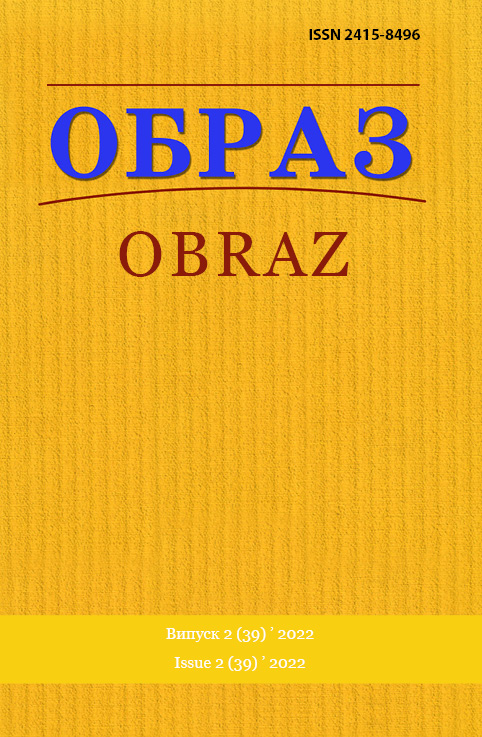Abstract
Introduction. Franchising magazines for men are one of the least researched segments of the Ukrainian media market. However, men’s magazines are quite interesting for research, because, like any media, they reflect reality, social processes, values, moral guidelines, and attitudes. One of the most famous men’s magazines in the world is Playboy magazine. Although a significant part of its content is indeed erotic photos, the magazine also provides the reader with interesting and useful information – news, interviews, analytics, and author’s journalism.
Relevance of the study. The basis of our research is the author’s texts of the magazine
«Playboy Ukraine», as they are a product of creativity of representatives of Ukrainian society, and therefore a reflection of its worldview, mentality, and local social processes from the middle of the country. The purpose of our research is to determine the problem-thematic range of the author’s texts of the franchise magazine for men «Playboy Ukraine».
Methodology. The main research methods are content analysis and discourse analysis, which involve the identification of the author’s publications from among the content of the magazine issues, as well as the establishment of their thematic and content direction, author’s features of information presentation and evaluations as part of the general communication strategy of the publication.
Results. Investigating the problem-thematic range of the magazine «Playboy Ukraine», we analyzed the author’s texts of the printed version of the magazine in the period from 2017 to the end of 2021, as well as issues published after February 24, 2022. We divided the author’s texts highlighted in the magazine into thematic groups: healthy lifestyle, psychology, social stereotypes, modern culture, travel. We paid special attention to the topic of quarantine. It was also discovered that with the beginning of the full-scale invasion of Ukraine by the Russian army, «Playboy Ukraine» magazine completely reformatted its content. The first military issue is dedicated to the events in Ukraine. It does not contain erotic photos and author’s texts, the publication presents many photos by well-known and unknown photographers that show the consequences of enemy shelling, people hiding in bomb shelters, the military, evacuation and Ukrainian cities that have just been liberated from occupation. The editors dedicated the next issue of «Playboy Ukraine» to art during the war.
Conclusions. The thematic direction of the materials of the «Playboy Ukraine» magazine confirms the publication’s general focus on quality content. Therefore, the general problem- thematic range of the magazine reflects social processes and the surrounding reality, historical events, and realities of today, as well as a response to the informational tastes and interests of the audience. The perspective of further research consists in studying the problematic and thematic range of the author’s texts of the magazine in the context of historical events, as well as in comparison with the content of other franchise publications.
References
1. Bocharova, N.S. (2011), «Image of hegemonic masculinity in the Ukrainian media discourse (based on the men´s magazines)», Mizhnarodnyj Naukovyj Forum: Sociologiya, Psyxologiya, Pedagogika, Menedzhment [International Scientific Forum: Sociology, Psychology, Pedagogy, Management], issue 6, pp. 107–119.
2. Kalenych, V.M. (2013), «Modeling a man’s image on the pages of men’s glossy magazines», Svit Socialjnykh Komunikacij [World of Social Communications], vol. 9, pp. 59–62.
3. Kitsa, O. (2018), «Features of magazine periodicals for men in Ukraine: topics, genrology, perspectives», Poligrafiya i Vydavnycha Sprava [Printing and Publishing], no. 1 (75), pp. 147– 155.
4. Markova, H.E. (2014), «The halo of «immorality» and the effect of the «forbidden fruit» as components of the concept of a men’s magazine», Dialog: Media-studiyi [Dialogue: media studios], issue 18–19, pp. 383–391.
5. Мarkova, H. (2015), «Sexual revolution» and its influence on gender-slanted press formation», Visnyk Dnipropetrovskogo Universytetu. Seriya «Socialni Komunikaciyi» [Bulletin of Dnipropetrovsk University. Series «Social Communications»], issue 15, pp. 74–81.
6. Osypova, Yu.I. (2016), «The role of gender in the formation of media stereotypes (on the example of the magazine «Men’s Health»)», Actual Problems of the Modern Mass Media Space, Collection of Materials of the All-Ukrainian Scientific and Practical Conference, Khers. State University, Kherson, pp. 57–59.
7. Soboleva, O.V. (2015), «Actualization of gender-cultural differentiation of glossy publications», Naukovi Zapysky Nacionalnogo Universytetu «Ostrozka Akademiya». Seriya «Filologiya» [Scientific Notes of the National University «Ostroh Academy». Series «Philology»], issue 59, pp. 193–196.
8. Chornodon, M. (2013), «Metaphorical image of a man in the today’s glossy magazines», Naukovi Zapysky Instytutu Zhurnalistyky [Scientific Notes of the Institute of Journalism], no. 53, pp. 95–98.
9. Playboy Ukraine magazine, available at: https://playboy.ua/page/subscribe (accessed 20 July 2022).
10. Playboy Ukraine (2022), «Art in a time of war», available at: https://playboy.ua/art/ (accessed 20 July 2022).
11. Media business reports (2020), «Print is for the soul. We will make money on the other», Vlad Ivanenko on the purchase of the Playboy license and the future of the publication in Ukraine», available at: https://mbr.com.ua/ru/news/interview/2540-print-e-to-dlya-dusi-zarabaty-vatbudem-na-drugom-vlad-ivanenko-o-pokupke-licenzii-playboy-i-budushhem-izdaniya-v-ukraine (accessed 20 July 2022).
12. Focus (2022), «A special issue of Playboy magazine was dedicated to the war in Ukraine», available at: https://focus.ua/uk/lifestyle/511549-specvypusk-zhurnala-playboy-posvyatilivoyne-v-ukraine (accessed 20 July 2022).
13. Jancovich, M. (2001), «Placing Sex: Sexuality, Taste and Middlebrow Culture in the Reception of Playboy Magazine», Intensities: A Journal of Cult Media, pp. 1–14.
14. Newman, C. (2005), «Healthy, Wealthy and Globalized? Reader Letters to Australian Men’s Health Magazine», Continuum: A Journal of Media & Cultural Studies, vol. 19, no. 2, pp. 299–313.

This work is licensed under a Creative Commons Attribution 4.0 International License.

